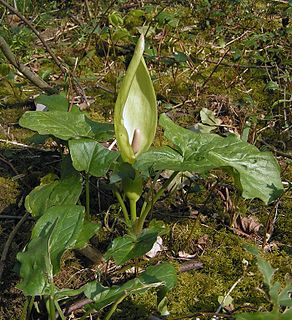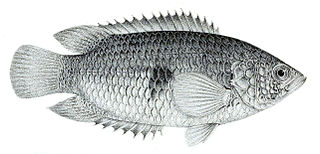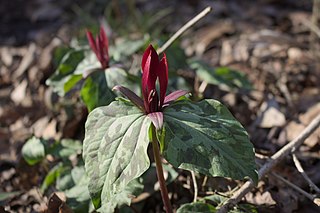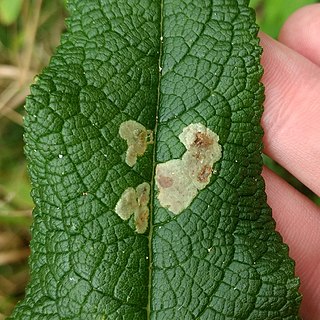
Geranium is a genus of 422 species of annual, biennial, and perennial plants that are commonly known as geraniums or cranesbills. They are found throughout the temperate regions of the world and the mountains of the tropics, but mostly in the eastern part of the Mediterranean region.

The spotted salamander or yellow-spotted salamander is a mole salamander common in eastern United States and Canada. The spotted salamander is the state amphibian of Ohio and South Carolina. This salamander ranges from Nova Scotia, to Lake Superior, to southern Georgia and Texas. Its embryos have been found to have symbiotic algae living inside them, the only known example of vertebrate cells hosting an endosymbiont microbe.

Hypericum is a genus of flowering plants in the family Hypericaceae. The genus has a nearly worldwide distribution, missing only from tropical lowlands, deserts and polar regions. Many Hypericum species are regarded as invasive species and noxious weeds. All members of the genus may be referred to as St. John's wort, and some are known as goatweed. The white or pink flowered marsh St. John's worts of North American and eastern Asia are now separated into the genus Triadenum.

Conium is one of more than 400 genera of flowering plants in the carrot family Apiaceae. As of December 2020, Plants of the World Online accepts six species.

Arum maculatum is a woodland flowering plant species in the family Araceae. It is widespread across most of Europe, as well as Turkey and the Caucasus. It is known by an abundance of common names including snakeshead, adder's root, arum, wild arum, arum lily, lords-and-ladies, devils and angels, cows and bulls, cuckoo-pint, soldiers diddies, priest's pintle, Adam and Eve, bobbins, naked girls, naked boys, starch-root, wake robin,friar's cowl, sonsie-give-us-your-hand, jack in the pulpit and cheese and toast. The name "lords-and-ladies" and other gender-related names refer to the plant's likeness to male and female genitalia symbolising copulation.

The spotted bat is a species of vesper bat and the only species of the genus Euderma.

Lamium maculatum is a species of flowering plant in the family Lamiaceae, native throughout Europe and temperate Asia.

Eutrochium maculatum, spotted joe-pyeweed, is a North American species of flowering plant in the sunflower family Asteraceae. It is widespread through much of the United States and Canada. It is the only species of the genus Eutrochium found west of the Great Plains.

Ornithogalum maculatum is a flowering plant native to the Cape Provinces of South Africa.

Hypericum maculatum, commonly known as imperforate St John's-wort, or spotted St. Johnswort, is a species of perennial herbaceous flowering plant in the family Hypericaceae. It is native to Europe and Western Asia where it grows in moist meadows.

Lilium maculatum is a plant in the lily family native to Japan.

The hemlock moth, also known as the defoliating hemlock moth or poison hemlock moth, is a nocturnal moth species of the family Depressariidae. Of Palaearctic origin, it was first found in North America in 1973 when it was accidentally introduced. The moth is now widespread throughout the northern half of the United States, southern Canada, northern Europe, and, more recently, New Zealand. The larval form grows to around 10 mm, while the adults wingspan is between 17 mm and 19 mm.

Conium maculatum, the hemlock or poison hemlock, is a highly poisonous biennial herbaceous flowering plant in the carrot family Apiaceae, native to Europe and North Africa. A hardy plant capable of living in a variety of environments, hemlock is widely naturalized in locations outside its native range, such as parts of North and South America, Australia and West Asia, to which it has been introduced.

Ctenopoma maculatum is a fish in the family Anabantidae found in the coastal rivers from South Cameroon to the Democratic Republic of the Congo in the Chad, Ogoué, and Congo River basins. They grow to 20.0 cm in total length.

Trillium maculatum, the spotted wakerobin or spotted trillium, is a species of flowering plant in the family Melanthiaceae. It is found only in the eastern United States.
Microstigma maculatum is a species of narrow-winged damselfly in the family Coenagrionidae. It is found in South America.

Brachycentrus is a genus of humpless casemaker caddisflies in the family Brachycentridae. There are at least 30 described species in Brachycentrus.

Boopedon nubilum, known generally as ebony grasshopper, is a species of slant-faced grasshopper in the family Acrididae. Other common names include the black-males grasshopper and plains boopie. It is found in Central America and North America.
Anorostoma is a genus of flies in the family Heleomyzidae. There are about 17 described species in Anorostoma.

Calycomyza flavinotum is a species of leaf miner fly. It creates whitish blotch-shaped mines on the leaves of Ageratina altissima, Arctium minus, Eupatorium spp., Eutrochium maculatum, and Eutrochium purpureum, all flowering plants in the sunflower family.
















